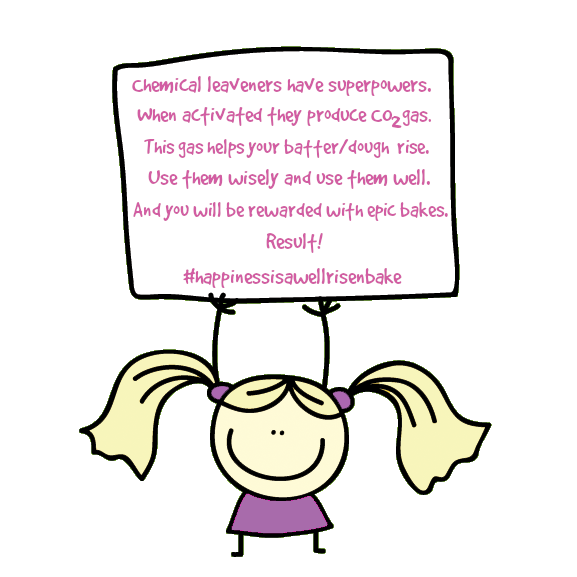If you’re not sure what the difference is between baking powder and bicarbonate of soda and when it is best to use one or the other (or sometimes both), then here’s a handy little guide for you. Getting to know and understand the ingredients you are baking with, how they work and when and why they are used, will help you to develop your baker’s instinct and ensure that you bake like a pro every time you turn on your oven 🙃

WHAT ARE BAKING POWDER AND BICARBONATE OF SODA?
They are both types of chemical leavening agent.
In other words, they are ingredients that will help your cakes and bakes rise in the oven by producing gas (CO₂ – carbon dioxide) from a chemical reaction with the other ingredients in your recipe.
The gas bubbles produced by the chemical reaction get trapped in the batter or dough, causing it to rise and produce a light and airy finished bake.
So if the job of a chemical leavener is to help cakes and bakes rise, they can be used interchangeably, yes?
Noooooo! There are important differences between baking powder and bicarbonate of soda and substituting one for the other may result in an epic bake fail and a very sad baker. Read on to make sure you only ever bake yourself happy…
WHAT IS BICARBONATE OF SODA?
Bicarbonate of soda (which is sometimes referred to as baking soda – particularly in the USA) is a single ingredient alkaline substance (sodium bicarbonate – NaHCO3) that relies on the introduction of an acid for it to do its thing.
When it reacts with an acid (plus moisture), it creates and emits carbon dioxide gas (CO₂). The gas cells created are trapped in the batter or dough, helping the bake to rise. Ingredients that are acidic include buttermilk, sour cream, creme fraiche and yoghurt, lemon/lime juice, vinegar, honey and treacle (molasses).
Recipes that call for bicarbonate of soda (bicarb) include cookies, soda bread, ginger cake, honeycomb (hokey pokey) and buttermilk pancakes.
WHAT IS BAKING POWDER?
Baking powder, unlike bicarb, is not a single ingredient. It is a mixture of bicarbonate of soda with an acidic ingredient (such as mono calcium phosphate or cream of tartar) added. It is not uncommon to also find a starch in baking powder’s ingredients, which is sometimes added to help protect against moisture damage. Typically this is cornstarch (cornflour in the UK) but not always, which is why it is always important for us coeliac bakers to check that the baking powder we are using is gluten-free (Dr. Oetker and Freee Foods by Doves Farm both sell gluten-free baking powder in the UK).
So while bicarbonate of soda needs the addition of an acidic ingredient in your recipe to trigger its chemical reaction, baking powder has everything you need right there – it just needs you to add a liquid (as does bicarb) to get fizzy with it 😉
Recipes that call for baking powder include Victoria sponge cake and other classic cakes following a fat, flour, sugar, eggs formula, scones, biscuits/cookies (where sometimes you will also see bicarb called for in the ingredients – more about that below!) and self-raising flour.
WHEN TO USE BOTH BAKING POWDER AND BICARBONATE OF SODA
There are some occasions in life when two is better than one. And baking is no exception. Sometimes you will find a recipe that calls for both baking powder and bicarbonate of soda. Why so?
Well on occasion you may find your bake is in need of a bit of extra oompf, which is where a combination of baking powder and bicarb comes in handy. While bicarb will quickly react with the acidic ingredient (for example, buttermilk) when the two are combined, baking powder has a little more of a leisurely approach to reacting and really needs the combination of liquid and heat to react. So the chemical reaction of the bicarb and the acid may not create enough of those gas bubbles needed to aerate your bake, which is where a little additional baking powder can go a long way.
Bicarbonate of soda also has another superpower in that it can help to promote the browning of baked goods (or accelerate the Maillard reaction to be more geeky about it). You will typically find bicarb and baking powder used together in cookie recipes because they’re often not in the oven for very long and are baked at low(ish) temperatures, which is not conducive to the Maillard reaction. Step in the bicarbonate of soda with its magical browning properties. Boom!
TOO MUCH OF A GOOD THING?
Baking powder and bicarbonate of soda bring a little bit of chemical wizzardry to the baking process but their use comes with a word of warning…use them to excess at your peril!
Add too much baking powder to your recipe and at best your finished bake will be a pretty holey affair from the formation of extra large gas bubbles. At worst, your bake will collapse in on itself as it will rise too quickly and the unbaked batter/dough will not have time to set and trap those lovely bubbles that are needed to produce a light and airy bake.
Too much bicarbonate of soda can lead to some pretty funky tasting bakes (also true of baking powder!) If the ratio of bicarb to acid is off in your recipe (too much bicarb to not enough acid) then you may end up with a bitter and/or curiously soapy tasting bake. Deeply unpleasant. Another uninvited side-effect of too much chemical leavener can be a weird, tingly sensation on your tongue. Or, as a pal of mine experiences it, itchy teeth. No thank you!
ENOUGH IS ENOUGH!
Both baking powder and bicarbonate of soda carry best before dates (BBEs). Ignore these at your peril! With many store cupboard ingredients, these BBEs are wildly conservative and by sticking religiously to them, you could be throwing out perfectly useable ingredients.
Best before dates are an indication of product quality, not food safety (that’s what use by dates are for) and typically ingredients can be perfectly good to use far beyond their given shelf life. That said, both bicarb and baking powder can lose their potency with age, so they are two ingredients that I would always recommend you use within their BBE date.
A partially risen bake is a sorry state of affairs, so ditch that pot of baking powder from circa 2019 lurking at the back of your cupboard, buy yourself a fresh pot and prepare to bake yourself happy with light and lofty cakes!
SO IN SUMMARY…









